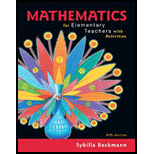
Concept explainers
Write the following numbers as powers of 10:
- 0.000001
- 10,000,000
- the number whose decimal representation is a 1 followed by 50 zeros
- the number whose decimal representation is a decimal point followed by 10 zeros, followed by a 1
- the number whose decimal representation is a decimal point followed by 50 zeros, followed by a 1
a.
To write:
The given numbers as a power of 10.
Answer to Problem 1P
Explanation of Solution
Given:
A number:
Calculation:
First of all, we will write
Now, we will write
Using property
Therefore,
b.
To write:
The given numbers as a power of 10.
Answer to Problem 1P
Explanation of Solution
Given:
A number:
Calculation:
We can see that there are 7 zeros after 1, this means that 10 is multiplied to itself by 7 times.
We can write
Therefore,
c.
To write:
The given numbers as a power of 10.
Answer to Problem 1P
1 followed by 50 zeros as a power of 10 would be
Explanation of Solution
Given:
A number, whose decimal representation is a 1 followed by 50 zeros.
Calculation:
1 followed by 50 zerosmeans that 1 followed by 50 zeros that is 10 multiplied to itself by 50 times.
We can write 1 followed by 50 zeros as a power of 10 by raising 10 to 50th power as:
Therefore,1 followed by 50 zerosas a power of 10 would be
d.
To write:
The given numbers as a power of 10.
Answer to Problem 1P
A decimal point followed by 10 zeros, followed by a1 as a power of 10 would be
Explanation of Solution
Given:
A number, whose decimal representation is a decimal point followed by 10 zeros, followed by a1.
Calculation:
A decimal point followed by 10 zeros, followed by a 1 would be
We will write
Using property
Therefore,
d.
To write:
The given numbers as a power of 10.
Answer to Problem 1P
A decimal point followed by 50 zeros, followed by a 1as a power of 10 would be
Explanation of Solution
Given:
A number, whose decimal representation is a decimal point followed by 50 zeros, followed by a 1.
Calculation:
A decimal point followed by 150 zeros, followed by a 1 would be
To write
Therefore,
Want to see more full solutions like this?
Chapter 5 Solutions
Pearson eText for Mathematics for Elementary Teachers with Activities -- Instant Access (Pearson+)
Additional Math Textbook Solutions
A First Course in Probability (10th Edition)
Calculus for Business, Economics, Life Sciences, and Social Sciences (14th Edition)
Basic Business Statistics, Student Value Edition
Intro Stats, Books a la Carte Edition (5th Edition)
Thinking Mathematically (6th Edition)
- Evaluate = f J dx by using Simpson's rule, 2n=10. 2arrow_forwardUse Euler and Heun methods to solve y' = 2y-x, h=0.1, y(0)=0, compute y₁ y5, calculate the Abs_Error.arrow_forwardUse Heun's method to numerically integrate dy dx = -2x3 +12x² - 20x+8.5 from x=0 to x=4 with a step size of 0.5. The initial condition at x=0 is y=1. Recall that the exact solution is given by y = -0.5x + 4x³- 10x² + 8.5x+1arrow_forward
- B: Study the stability of critical points of ODES: *+(x²-2x²-1)x+x=0 and draw the phase portrait.arrow_forwardB: Study the stability of critical points of ODEs: -2x²+x²+x-2=0 and draw the phase portrait.arrow_forward2/ Draw the phase portrait and determine the stability of critical point: ✗ 00 +2X°-x²+1=0arrow_forward
- study the stability of critical point of oDES: 2 200+ (x² - 2x² - 1) + x=0 and draw the phase portrait.arrow_forwardQ/study the stability of critical point and draw the phase portrait:- to -x-x³ x = 0arrow_forwardB: Find the linearization of: x= ex+y-1 y=-x+xy 26-1 e e-10 at critical points then discuss the application of Hartman theorem.arrow_forward
 College Algebra (MindTap Course List)AlgebraISBN:9781305652231Author:R. David Gustafson, Jeff HughesPublisher:Cengage Learning
College Algebra (MindTap Course List)AlgebraISBN:9781305652231Author:R. David Gustafson, Jeff HughesPublisher:Cengage Learning Algebra: Structure And Method, Book 1AlgebraISBN:9780395977224Author:Richard G. Brown, Mary P. Dolciani, Robert H. Sorgenfrey, William L. ColePublisher:McDougal Littell
Algebra: Structure And Method, Book 1AlgebraISBN:9780395977224Author:Richard G. Brown, Mary P. Dolciani, Robert H. Sorgenfrey, William L. ColePublisher:McDougal Littell Holt Mcdougal Larson Pre-algebra: Student Edition...AlgebraISBN:9780547587776Author:HOLT MCDOUGALPublisher:HOLT MCDOUGAL
Holt Mcdougal Larson Pre-algebra: Student Edition...AlgebraISBN:9780547587776Author:HOLT MCDOUGALPublisher:HOLT MCDOUGAL- Algebra & Trigonometry with Analytic GeometryAlgebraISBN:9781133382119Author:SwokowskiPublisher:Cengage
 Mathematics For Machine TechnologyAdvanced MathISBN:9781337798310Author:Peterson, John.Publisher:Cengage Learning,
Mathematics For Machine TechnologyAdvanced MathISBN:9781337798310Author:Peterson, John.Publisher:Cengage Learning, Elementary AlgebraAlgebraISBN:9780998625713Author:Lynn Marecek, MaryAnne Anthony-SmithPublisher:OpenStax - Rice University
Elementary AlgebraAlgebraISBN:9780998625713Author:Lynn Marecek, MaryAnne Anthony-SmithPublisher:OpenStax - Rice University





